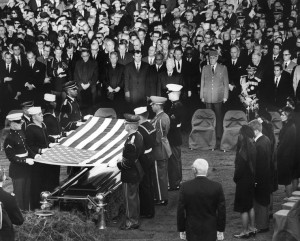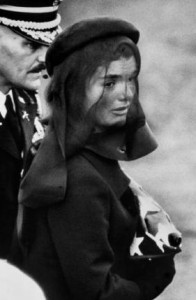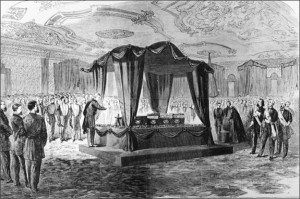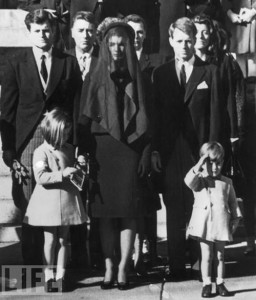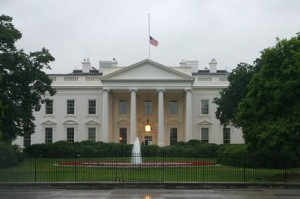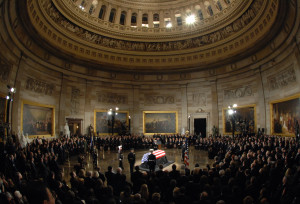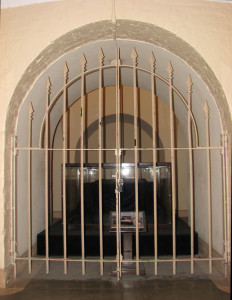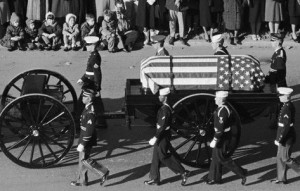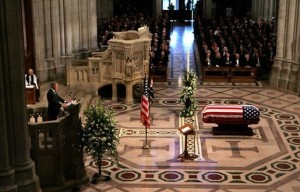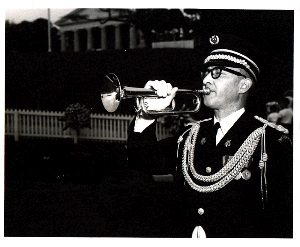During the month of February we celebrate President’s Day and I thought I would take the opportunity to talk about Presidential Funerals. In recent years, a sitting president (meaning a current president still in office) will start to plan his funeral. I know it sounds a little morbid for a person to plan their funeral when they are still living, but in the case of a State funeral held in the nation’s capital advance planning is needed to coordinate the many details involved such as the lying in state, the funeral procession and service, followed by the interment or burial.
So, let’s start by discussing the funeral of the first President of the United States, George Washington, and then move forward to more recent time.
When George Washington died in 1799 at his home at Mount Vernon, Virginia and it had only been two years since he had voluntarily left the office of President of the United States. Four days after his death his immediate family held a funeral at a church near Mount Vernon with traditional Masonic funeral rites and he was interred in a vault located a short distance away closer to the Potomac River. Since news traveled very slowly, by the time the people in Philadelphia (the U.S. Capital at that time) heard that Washington had died Congress immediately called for December 26 to be a day of official mourning. That day started with a sixteen cannon salute, followed by a procession of the members of Congress, military units and others to the Zion Lutheran Church for a memorial service. Initially Congress had requested that Washington remains be moved to the new national capital being built, which was renamed Washington, D.C. in his honor, and although the family this request Washington remains stayed at Mt. Vernon. (Shown below in the first photo is the Washington procession in Philadelphia, the next photo shows the Washington grave site at Mt. Vernon. For more visitor information about planning a trip to Mount Vernon or information on the history of the Washington Monument and how it came to be built in Washington D.C. please click on the links)
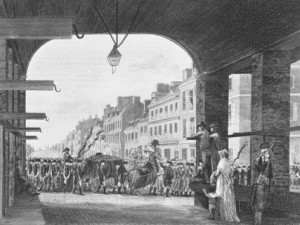
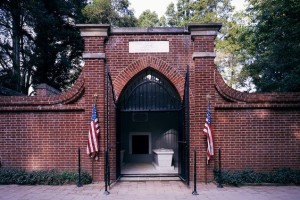
As the 50th anniversary of the Declaration of Independence was being planned two of the original founding fathers were on their deathbeds; John Adams in Quincy, Massachusetts and Thomas Jefferson at Monticello in Virginia. After a falling out in their relationship over opposing political views, the two former Presidents of the United States had near the end of their lives renewed their friendship and correspondence. On July 4, 1826, each knew the other was seriously ill and Jefferson died earlier in the day and then Adams just five hours later. Per Jefferson’s request a small service was held the day after his death in Charlottesville, Virginia with a private burial at Monticello attended by only his immediate family and close friends; a granite obelisk marks the gravesite with a simple inscription according to Jefferson wishes. (The two photos below show the Jefferson gravesite at Monticello. For more information about Jefferson’s Monticello estate, please click on the link)
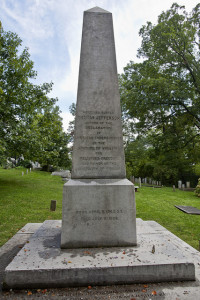
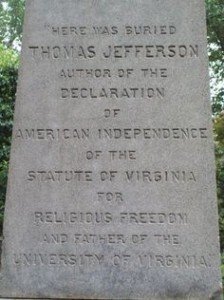
The funeral of Adams started with the firing of ceremonial cannons, a procession including the Governor of Massachusetts and other prominent political men, followed by a funeral service held at a church attended by over 4,000 people before Adams was interred in Hancock Cemetery. Years later, a basement crypt was built in the basement of the United First Parish Church across from the cemetery and is the final resting place of John and Abigail Adams. (Shown below are two photos of the grave site of Adams)
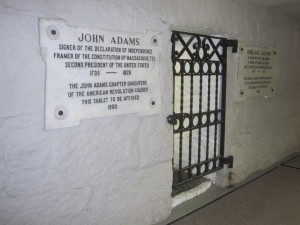
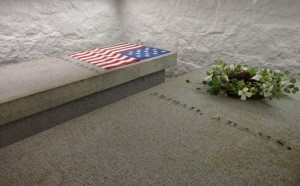
The first president to die while still in office was William Harrison on April 4, 1841. President Harrison is known to have given the longest inaugural speech and to have served the shortest term as president, it was only 30 days. It has been said that his two hour speech in the cold and wet weather led to his illness and subsequent death from pneumonia. At the time of Harrison’s death there was still not a regulated procedure for dealing with the funerals of the presidents so the White House was draped in black and a religious service by invitation only that was held in the East Room, it was the first State funeral. Later there was another service held back in Cincinnati, Ohio and Harrison was interred at the Congressional Cemetery in Washington, D.C. but then he was re-interred in North Bend, Ohio.
When Abraham Lincoln was assassinated on April 14, 1865, the news spread quickly throughout the country due to the telegraph system of communication and it was the first time there was an official national mourning period. Lincoln’s body lay in state for several days with an honor guard keeping watch day and night while the general public was allowed to pay their respects. In the East Room a special catafalque was built for the casket which was set on a raised platform with a canopy overhead supported by four pillars and covered with black cloth lined with white silk. (Shown below is Lincoln’s catafalque in the East Room of the White House)
A brief service was held in the Green Room on April 19 and then a funeral procession made its way from the White House slowly down Pennsylvania Ave. to the U.S. Capitol in a specially built hearse carriage drawn by a team of six gray horses. Lincoln lay in state in the Capitol Rotunda until April 20 and on the morning of April 21 a final prayer service was held with Lincoln’s cabinet in attendance and afterwards the hearse carriage made its way to the train station, it moved slowly through the streets of Washington, D.C. Once at the railway station Lincoln’s casket was loaded onto a special funeral train for a long journey to Springfield, Illinois. The train would make the 1,700 mile journey through 7 states stopping in several major cities along the route, including New York, Indianapolis and Chicago. This was the first time that a train was used to transfer a president’s casket for burial in another state. With every stop there would be a funeral service before finally reaching Springfield 19 days later where he was finally interred at Oak Ridge Cemetery. The Lincoln tomb features a 117 foot tall obelisk, a terrace and elaborate bronze statues at the base; Lincoln is actually buried in a cement vault 10 feet below the floor. Special Note: Mary Todd Lincoln, the president’s wife, remained in Washington D.C. at the White House because she was too distraught to make the trip for the burial and she returned to their Springfield home about a month later. (Shown below in the first photo is the carriage which carried the body of Lincoln from the White House to the U.S. Capitol, the second photo shows the funeral train which carried Lincoln’s body back to Springfield and the final photo shows the train’s route across the country from Washington, D.C. to Springfield, Illinois)
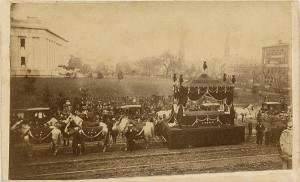
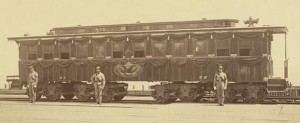
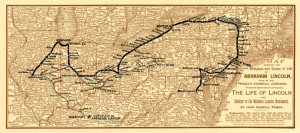
The photos below show the exterior and interior of the Lincoln Tomb in Springfield, IL. For more information on Lincoln’s Springfield home and the Lincoln Tomb, please click on the link.
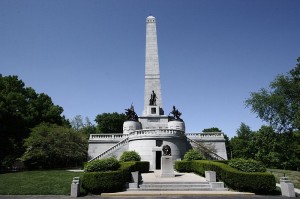
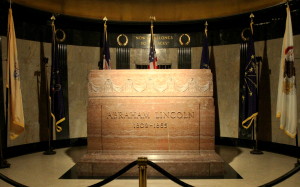
Special Historical Fact: Several years after the death of President Lincoln a historian was looking through photos of the funeral procession when it had passed through New York City on April 25, 1865. In a strange coincidence, shown in the photo are a very young Teddy Roosevelt, the future President of the United States, and his brother Elliot in the window of the home of their grandfather, Cornelius Roosevelt, which was located on Broadway. (Shown below in the upper left portion of the photo Teddy and Elliot Roosevelt can be seen in the window of the building)
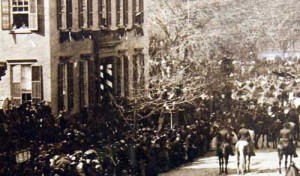 When Franklin Roosevelt, a distant cousin of Teddy Roosevelt, died on April 12, 1945 in Warm Springs, Georgia it had been only six weeks since his inauguration for an unprecedented fourth term. Since World War II was still being fought overseas it was determined that the funeral plans should be subdued. Franklin’s body was transferred by train to Washington, D.C. arriving on April 14 where it was set onto a caisson with a military guard as it traveled from Union Station to the White House where the casket was set on a catafalque in the East Room. A private funeral service was held at the White House which was attended by immediate family, friends, members of Congress and other foreign dignitaries while flags were lowered at half-staff at both the White House and the Capitol. Roosevelt’s casket was reloaded on to the caisson to be taken back to Union Station to travel to Hyde Park, New York for burial at the Roosevelt Estate, Springwood. (Shown below are two photos of the funeral of FDR at Springwood in Hyde Park, NY. For more information on the FDR National Historic Park which was Roosevelt’s childhood home and his final resting place, please click on the link)
When Franklin Roosevelt, a distant cousin of Teddy Roosevelt, died on April 12, 1945 in Warm Springs, Georgia it had been only six weeks since his inauguration for an unprecedented fourth term. Since World War II was still being fought overseas it was determined that the funeral plans should be subdued. Franklin’s body was transferred by train to Washington, D.C. arriving on April 14 where it was set onto a caisson with a military guard as it traveled from Union Station to the White House where the casket was set on a catafalque in the East Room. A private funeral service was held at the White House which was attended by immediate family, friends, members of Congress and other foreign dignitaries while flags were lowered at half-staff at both the White House and the Capitol. Roosevelt’s casket was reloaded on to the caisson to be taken back to Union Station to travel to Hyde Park, New York for burial at the Roosevelt Estate, Springwood. (Shown below are two photos of the funeral of FDR at Springwood in Hyde Park, NY. For more information on the FDR National Historic Park which was Roosevelt’s childhood home and his final resting place, please click on the link)
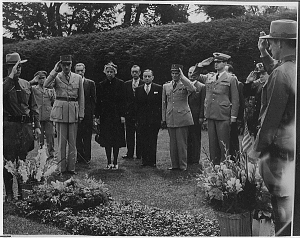
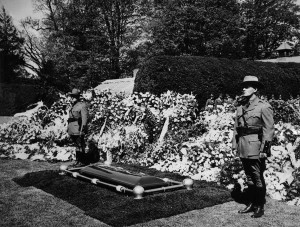
John Kennedy was the most recent president to die while in office when he was assassinated on November 22, 1963 in Dallas, Texas. Perhaps one of the most tragic passing of a president due to the fact that the country was witness to the event as it was broadcast on national television. The body of Kennedy was transferred from Texas to Washington, D.C. aboard the presidential plane, Air Force One. Jacqueline Kennedy, the president’s widow, sent instructions to the White House staff to begin preparations for a state funeral with many elements similar to Lincoln’s funeral which happened almost a century earlier, extensive research was done so as not to miss any details. The East Room at the White House was draped in black material and a private service was held for the immediate family.
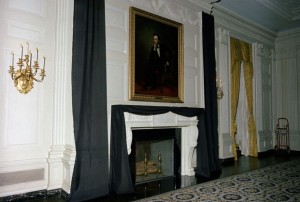
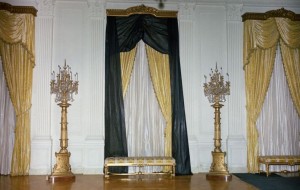
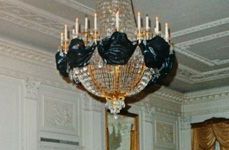
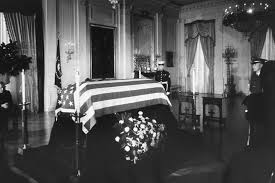 Then, two days later the flag-draped coffin was loaded on a horse-drawn caisson, the same one used for FDR, and taken from the White House as rows of soldiers lined the driveway with the flags from the 50 states. The procession continued down Pennsylvania Ave to the U.S. Capitol accompanied by the sound of muffled drums were Kennedy lay in state for several days in the Rotunda while several thousands of people lined up for the public viewing while a military honor guard stood watch, because of the amount of people waiting the time of the viewing extended well into the night. Meanwhile, state and foreign dignitaries started to gather in Washington, D.C. for the funeral created major security problems for law enforcement officials.
Then, two days later the flag-draped coffin was loaded on a horse-drawn caisson, the same one used for FDR, and taken from the White House as rows of soldiers lined the driveway with the flags from the 50 states. The procession continued down Pennsylvania Ave to the U.S. Capitol accompanied by the sound of muffled drums were Kennedy lay in state for several days in the Rotunda while several thousands of people lined up for the public viewing while a military honor guard stood watch, because of the amount of people waiting the time of the viewing extended well into the night. Meanwhile, state and foreign dignitaries started to gather in Washington, D.C. for the funeral created major security problems for law enforcement officials.
The State Funeral for President Kennedy was held on November 25 and the day started with a procession from the U.S. Capitol back to the White House and then on to St. Matthew Catholic Church and a final burial at Arlington National Cemetery. Approximately one million people lined the route and the entire nation watched the entire funeral broadcast on television. (The assassination of President Kennedy is one of those moments in time that people of my generation will remember exactly where they were when they heard the news and who can forget the quiet dignity of Mrs. Kennedy, the young widow, holding the hand of her young daughter, Caroline or image of “John-John” saluting his father’s casket.)
Presidential Funerals Traditions and Customs
Flag at half-staff –
At the death of the president an executive order is given to lower the United States flag to half-staff on all federal government buildings and offices, military bases and public schools as a sign of honor and respect, any other flags flying over the same buildings will also be lowered to half-staff. The order usually indicates that the flags remain at half-staff for a period of thirty days. The sitting president can also issue an executive order for all federal departments and their buildings to be closed on a national day of mourning for a state funeral.
Lay in state –
President Abraham Lincoln was the first president lay in state in the U.S. Capitol Rotunda, since that time there have been 11 presidents accorded the same privilege. A president who dies while in office customarily lies in repose in the East Room of the White House and then is moved in a solemn procession to the U.S. Capitol. A former president can also lay in state at their home or, if one has been built, their presidential library before being given the optional honor of being moved to Washington, D.C. where they lay in lay in the Capitol rotunda.
Once the body of the president has arrived at the Capitol Rotunda the casket is placed on top of the Lincoln catafalque for a special memorial service attended by the president’s family, the members of the U.S. Congress and other dignitaries, floral wreaths are set near the catafalque in honor the deceased. Soldiers comprised of each branch of the U.S. Armed Forces will stand guard while the room is then open to the general public for viewing.
Special Note: The Lincoln catafalque is the same one used in 1865 to hold the casket of Abraham Lincoln and since that time it has been used for anyone that is lies in state in the U.S. Capitol Rotunda. When not in use, the catafalque is stored in a special vaulted chamber located at the Capitol Visitor Center as shown in the photo below.
Funeral processions –
For a presidential state funeral a procession travels down either Pennsylvania or Constitution Avenue from the White House to the U.S. Capitol. The flag draped casket is placed onto a military caisson pulled by a matching set of six horses accompanied by three riders with eight military soldiers marching alongside (four on each side) of the caisson. For a funeral procession of a president who dies while in office, the casket/caisson will leave from the North Portico of the White House and proceed down Pennsylvania Ave. to the U.S. Capitol while a former president’s casket will be transferred from a hearse meet near the South Lawn of the White House, placed onto the caisson and then will proceed down Constitution Ave.
In general, in front of the presidential casket and caisson in the funeral procession are usually three military units with members representing the five branches of the U.S. Armed Forces, accompanying each unit is a military band and a color guard. Following the casket/caisson is a riderless horse and then a motorcade consisting of the deceased president’s family, government officials and foreign dignitaries. Then, as the procession nears the halfway point between the White House and the U.S. Capitol there is a military flyover consisting of 21 aircraft from the U.S. Air Force. The aircraft fly in formation and the third aircraft in the final unit will perform a maneuver known as the “missing man” by briefly veering away from the formation as a sign of honor and respect for the deceased president. Upon reaching the U.S. Capitol, the funeral procession will traditionally stop at the east front of the building. Special Note: One exception to this custom was for Ronald Reagan who had requested that his casket be brought into the west front of the Capitol because this side of the building faces his beloved California where he had previously served as the Governor.
Caisson –
As previously mentioned, in a state funeral procession of a president sometimes the casket is placed on a caisson. A caisson is a two wheel horse drawn wagon which was originally used to transport ammunition during military battles, the caisson used in presidential funeral procession was built in 1918 to carry a 75mm cannon. The caisson is attached to a limber which is a separate two-wheel horse drawn wagon; the original purpose of a limber was for moving two-wheel canons into position on a battlefield for firing at enemy targets. (Shown below is the caisson used at the funeral of John Kennedy)
Riderless horse –
A riderless horse in a presidential funeral procession usually follows the casket/caisson and it is a distinct honor for U.S. presidents, it is also given to high ranking military officers of the U.S. Army or Marines. A single military guard will lead the horse with a pair of riding boots customarily reversed in the stirrups; this is traditionally a symbol of a fallen soldier who will never ride again. This custom was first used in 1799 for the funeral procession for George Washington which took place in Philadelphia, PA; Washington’s boots, saddle, holsters and pistols were also used. In 1865 for the funeral procession of Abraham Lincoln in Springfield, IL a horse named “Old Bob” draped with a black mourning blanket with fringe. For the funeral procession of John Kennedy in 1963 a horse named “Black Jack” was used, the famous horse was one of the last military horses to be branded with the Army’s US brand and he was also used for the state funerals of Presidents Herbert Hoover and Lyndon Johnson. In 2004 for the funeral procession of Ronald Reagan a horse named “Sergeant York” was used along with personal saddle and riding boots of the former president reversed in the stirrups; a ceremonial sword was also attached to the saddle. (The first photo shown below is the riderless horse used at Lincoln’s funeral, the second photo on the left is the horse used at Kennedy’s funeral and the third photo on the right is the horse used at Reagan’s funeral)
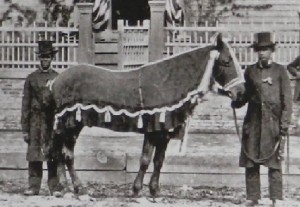
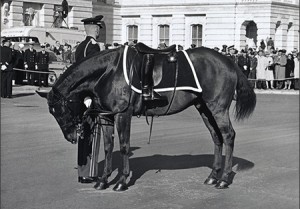
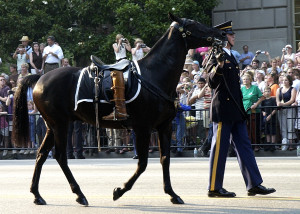
Funeral service –
In general, a presidential funeral service is traditionally held at the Washington National Cathedral in Washington, D.C but this decision is up to the president as determined per his request or his family. In the case of the only Catholic president to date, John Kennedy, the Cathedral of St. Matthew the Apostle was selected. Invited to the service are the president’s family and friends as well as former presidents and members of congress, various federal and state politicians and foreign heads of state and other dignitaries. The president’s immediate family is seated in the first rows and then other seating is determined by protocol with federal government officials and then foreign heads of state usually seated in alphabetical order to avoid any pleasantries. When the National Cathedral being used the president’s extended family sit on the south transept and military officers to the north. (Shown in the photo below is the funeral service for Ronald Reagan held at the National Cathedral in Washington, D.C. in 2004)
Immediately after the service, the casket is transported to the final resting place for burial. Unlike Lincoln’s long drawn out journey by train from Washington D.C. to Springfield, IL which took 19 days, with modern and fast transportation by an airplane departing from Andrews Naval Base the burial can normally be done within the same day. The plane is usually meet at its destination with honor guards, a military band and a 21 gun salute as the casket is taken from the plane and put into a waiting hearse to be taken to the burial site.
Military honors –
Given the fact that the U.S. President of the United States is the Commander in Chief of the U.S. Armed Forces he is accorded full military honors. During the service at the burial site there traditionally will be a 21 gun salute which is performed by seven military honor guards and they will fire their rifles simultaneously three times. Another honor performed at the burial site during the interment will be a bugle call, traditionally known as Taps, played by a member of the United States Marine Band who is located a short distance away. Another military honor is the aircraft flyby done by the United States Air Force for a final time with the missing man formation similar to the one performed during the funeral procession in Washington D.C. (Shown below is the bugler from the Kennedy burial service at Arlington National Cemetery in 1963)
One final honor at a presidential funeral is the folding of the flag of the United States and the presentation to the president’s spouse. At the completion of the service at the grave site, the flag draped over the casket is ceremoniously folded twelve times by a military honor guard of eight soldiers, four stationed on each side of the casket. The folded flag, now in the shape of a triangle is solemnly presented. (Shown below in the photos are on the left the flag folding ceremony at John Kennedy’s grave site service and on the left is the flag presentation to Jaqueline Kennedy)
